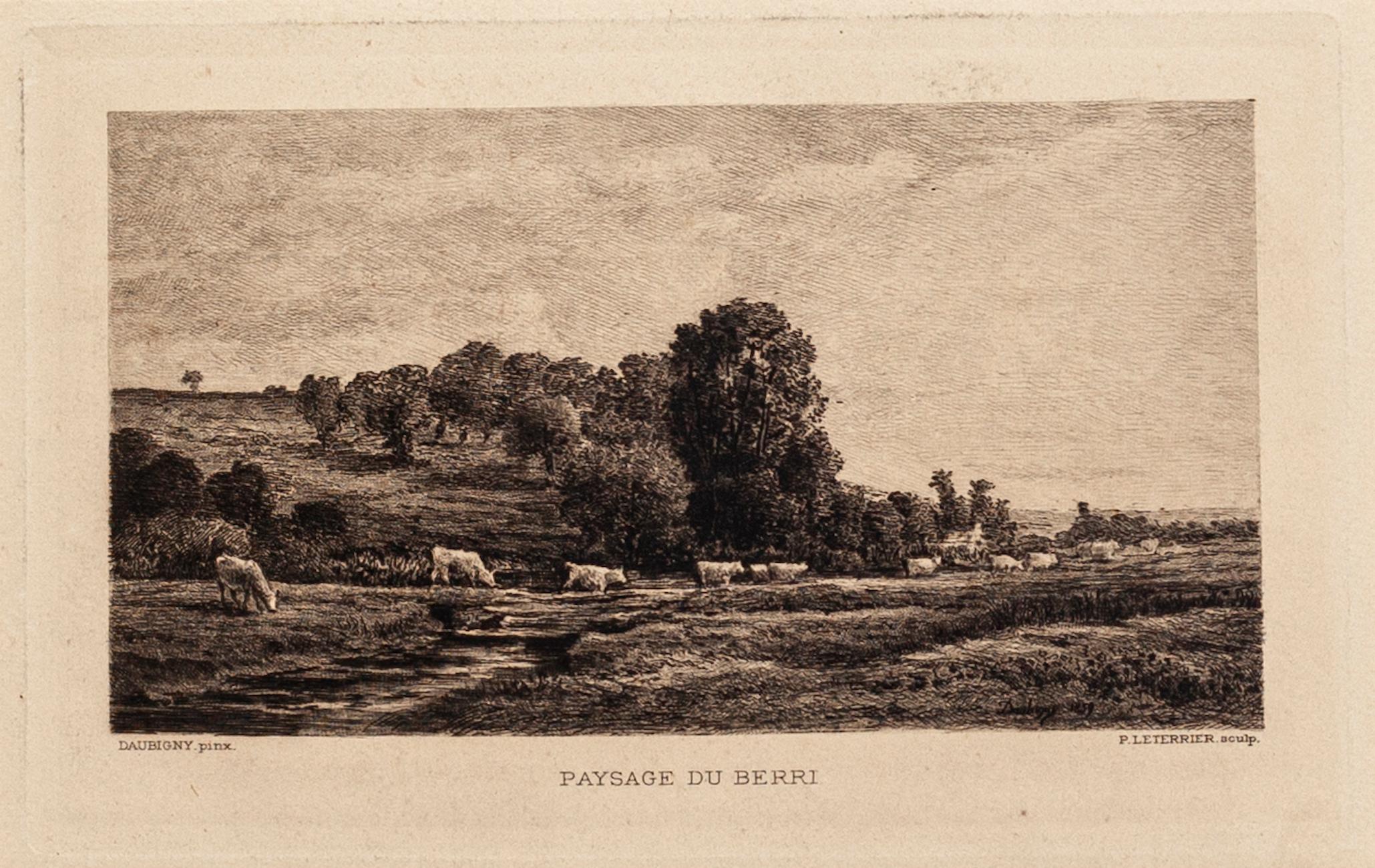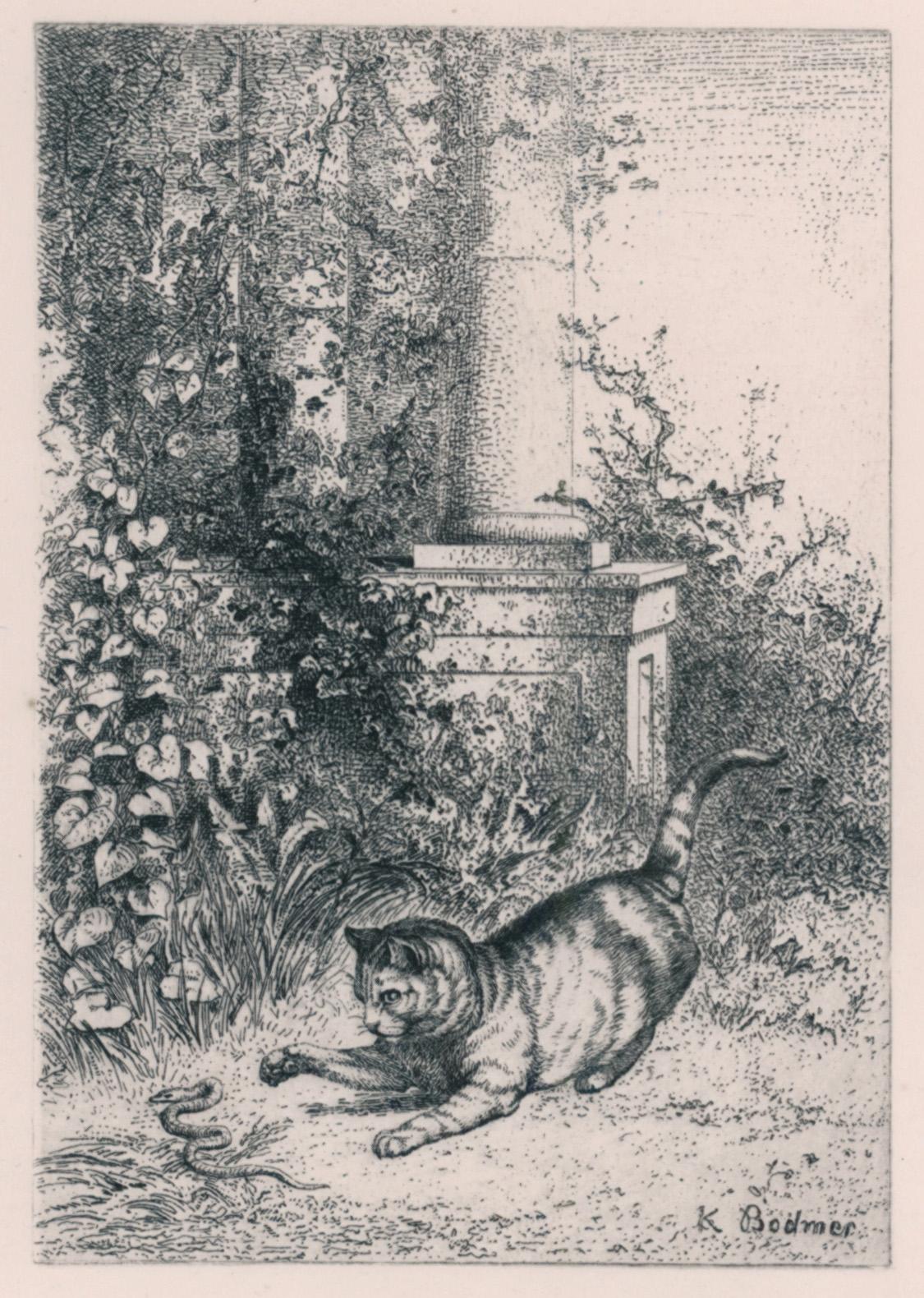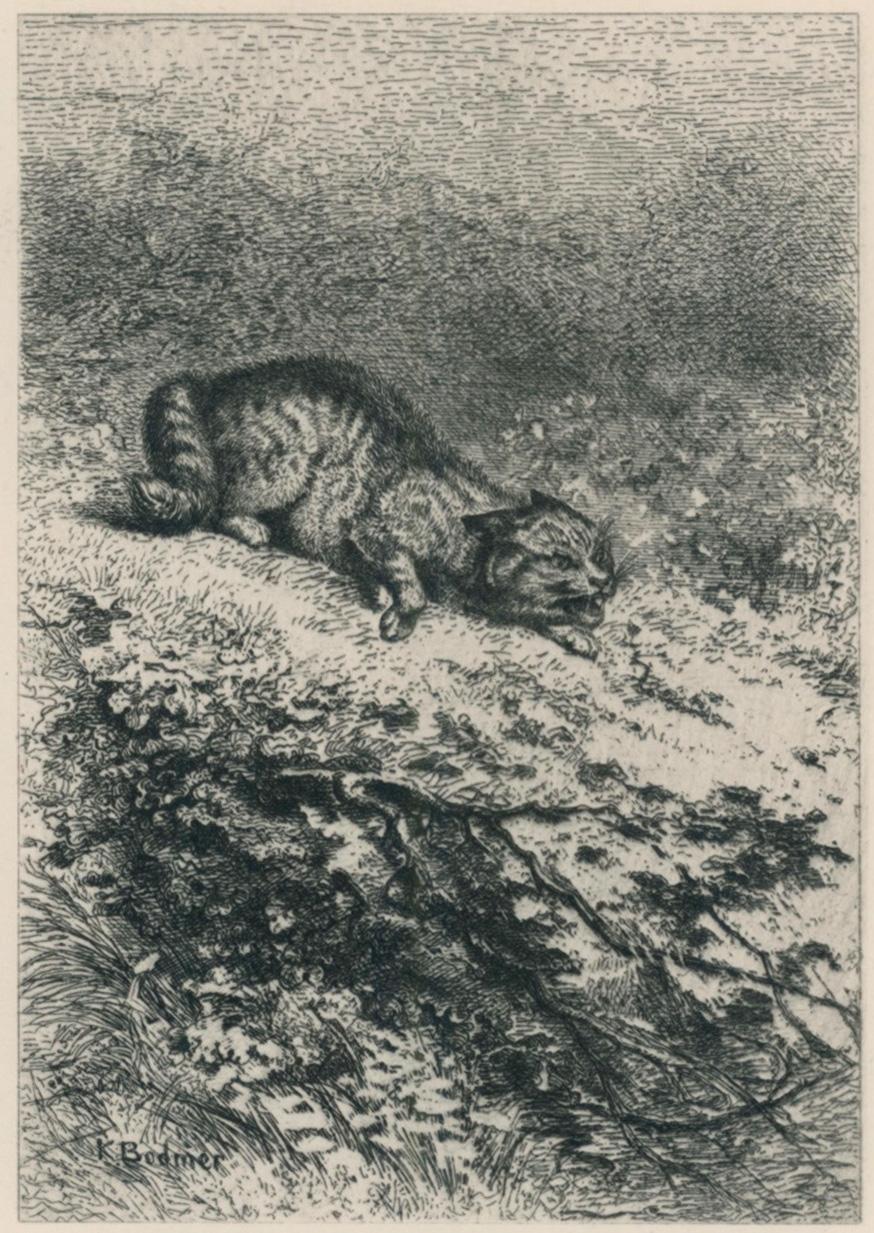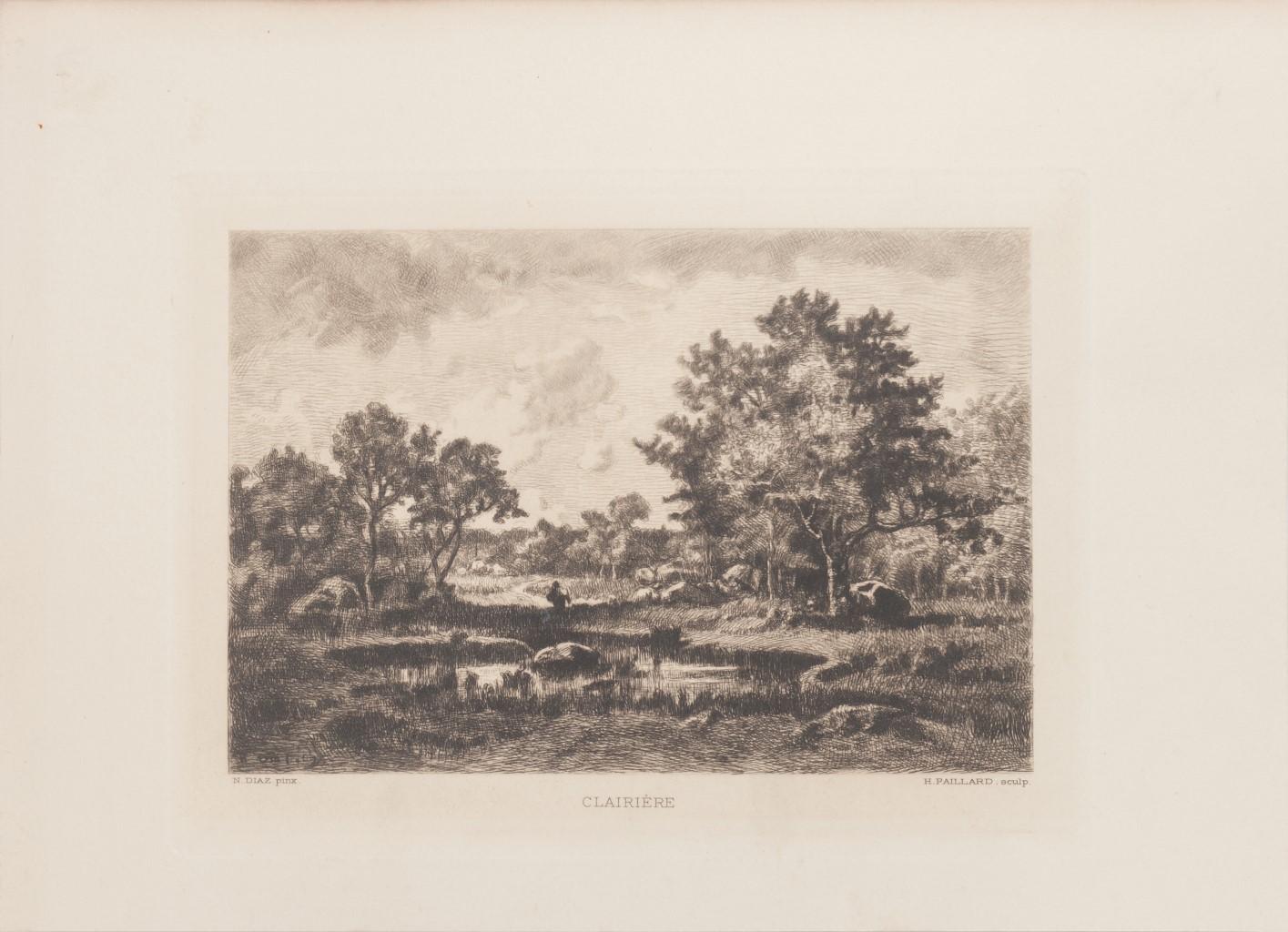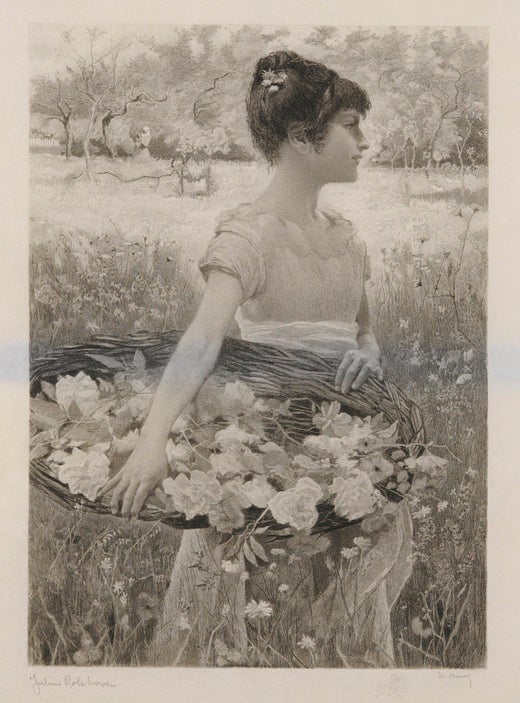Theophile Narcisse ChauvelConnais-tu le Pays (Primavera) apres J. Rolshoven (Do you Know the Country)1889
1889
About the Item
- Creator:Theophile Narcisse Chauvel (1831 - 1909, French)
- Creation Year:1889
- Dimensions:Height: 17.375 in (44.14 cm)Width: 12.5 in (31.75 cm)
- Medium:
- Movement & Style:
- Period:
- Condition:
- Gallery Location:Fairlawn, OH
- Reference Number:
Theophile Narcisse Chauvel
A pupil of François-Édouard Picot and Jean-Joseph Bellel, Théophile Chauvel entered the Imperial School of Fine Arts on March 4, 1854. In the same year, he won second prize in Rome for historical landscape. He first entered the Paris Salon in 1855, where he painted and exhibited until 1859. At that time, he devoted himself to dry point, a type of lithography and etching, from 1861 to 1867 where he represented, among other things, views of the forest of Fontainebleau, then reproductions of works by the masters of the Barbizon school.
From 1874–75, Chauvel worked for the annual album L'Eau forte and the magazine L'Art, of which he became director in the 1890s and in which were reproduced his prints after Théodore Rousseau, Jules Dupré, Narcissus Díaz de la Peña, and Charles-François Daubigny. But it is in his engravings of interpretation of Corot that he asserts all his mastery. Chauvel was a medalist at the Salon in 1870, 1873 and 1878. He won the medal of honor at the Salon des Artistes Français, the first awarded to the engraving section, in 1881. He was awarded the grand prix of the Salon in 1889 and 1900. He was appointed Knight of the Legion of Honor in 1879, then promoted to Officer of the same order in 1896.
- ShippingRetrieving quote...Ships From: Fairlawn, OH
- Return PolicyA return for this item may be initiated within 10 days of delivery.
- Lola De ValenceBy Édouard ManetLocated in Fairlawn, OHLola De Valence Etching, 1862 Signed in the plate lower left: “Ed Manet” Printed on chine collee paper, without watermark From the first edition, published by Cadart and Luquet, Paris, before the removal of the inscription “ Ed. Manet sculpt” From the 1863 edition, before the 1874 Portfolio, 1890 Portolio. 1894 Dumont edition and the Strolin edition of 100 in 1905 Pencil inscription with title below the plate in the lower margin Conditiono: Excellent Image size: 10 7/8 x 6 7/8 inches Plate size: 18 3/4 x 13 inches Reference: Harris-Manet 33 iii/III Guerin-Manet 23 vi/VIII The painting that this etching is inspired by is in the collection of the Musee d'Orsay, Paris. "Lola de Valence is a painting by the painter Édouard Manet in 1862 . The canvas represents a dancer dressed intraditional Spanish clothes...Category
1860s Impressionist Figurative Prints
MaterialsEtching
- Figure Study (From Interior: Evening)By Stone RobertsLocated in Fairlawn, OHSigned and numbered by the artist Edition: 25 Printed on Hahnemuhle paper Published by Neptune Fine Arts Condition: excellent Plate/Image size: Sheet size: "Stone Roberts’ luminous still lifes, private interiors, and large-scale panoramas of figures in motion invite us to look—and then look some more—and relish in the sensuality of the three-dimensional world. While Roberts’ varied influences include Greek Mythology and Roman Classicism, Dutch and Spanish Old Masters, Fantin-Latour, Ingres, and Balthus, his subjects are decidedly of today. From Grand Central Terminal to his wife gardening in Stonington, Connecticut, Roberts paints people and places from his personal surroundings into formal compositions that often appear to have mythical, literary, or psychological elements. Roberts received his B.A. from Yale University, New Haven, CT, where he studied painting with William Bailey, and his M.F.A. from the Tyler School of Art, Philadelphia, and Rome. Roberts' work can be found in numerous public and private collections throughout the United States and Europe, including the collection of The Metropolitan Museum of Art and the Louis-Dreyfus Family Collection, New York. A solo exhibition of Stone Roberts’ work was held at the Museum of the City of New York in 2012 entitled Stone Roberts: New York City Paintings." Courtesy of Hirschl & Adler Modern PUBLIC COLLECTIONS Asheville Art Museum, Asheville, NC Sydney and Walda Besthoff Biltmore Estate, Asheville, NC Mrs. Robert Carroll Mr. and Mrs. Willam Cecil Chase Manhattan Bank, New York, NY Evansville Museum of Arts and Sciences, Evansville, IN Jerald Dillon Fessenden Flint Institute of Arts, Flint, MI Ms. Barbara Goldsmith Mrs. Paul Gottlieb Mr. and Mrs. Graham Gund Mr. and Mrs. Arie L. Kopelman Alex S. Jones William Louis-Dreyfus Mr. and Mrs. James C. Marlas J.D. McClatchy and Chip Kidd Mr. and Mrs. Richard L. Menschel The Metropolitan Museum of Art, New York, NY Mrs. Stephen Paine Mr. and Mrs. W.J.W.J. van Roijen Mrs. Julius Rosenwald II Mark Singer Carl Spielvogel and Barbaralee Diamonstein-Spielvogel Bruce Springsteen and Patti Scialfa Stephens Inc., Little Rock, Arkansas Woodberry Forest...Category
20th Century American Realist Figurative Prints
MaterialsEtching
- Danseuses s'habillant (Laurence adjusting her hair and Mignon adjusting clothesBy Louis LegrandLocated in Fairlawn, OHDanseuses s'habillant (Laurence adjusting her hair and Mignon adjusting hre clothes) Drypoint & aquatint, 1893 Signed in the plate (see photo) After the division of the plate into A. 81 (as here) and A. 82 Divant la glace Editon 100 printed on velin paper Issued by Pellet in the set, Les Petites du Ballet, Gustave Pellet editeur, 1893 (13 plates), second state (b) without remarque Reference: Arwas 81, top portion of the plate vii/VIII Plate/Image size: 6 x 8 7/16 inches Condition: excellent Louis Auguste Mathieu Legrand (29 September 1863 – 1951) was a French artist, known especially for his aquatint engravings, which were sometimes erotic. He was awarded the Légion d'honneur for his work in 1906. Life Legrand was born in the city of Dijon in the east of France. He worked as a bank clerk before deciding to study art part-time at Dijon's Ecole des Beaux-Arts. He won the Devosge prize at the school in 1883.[2] In 1884 Legrand studied engraving under the Belgian printmaker Félicien Rops. Legrand's artworks include etchings, graphic art and paintings. His paintings featured Parisian social life. Many were of prostitutes, dancers and bar scenes, which featured a sense of eroticism. According to the Hope Gallery, "Louis Legrand is simply one of France's finest early twentieth century masters of etching." His black and white etchings especially provide a sense of decadence; they have been compared to those of Henri de Toulouse-Lautrec, though his drawings of the Moulin Rouge, the can-can dance and the young women of Montmartre preceded Toulouse-Lautrec's paintings of similar scenes. He made over three hundred prints of the night life of Paris. They demonstrate "his remarkable powers of observation and are executed with great skill, delicacy, and an ironic sense of humor that pervades them all." Two of his satirical artworks caused him to be tried for obscenity. The first, "Prostitution" was a symbolic drawing which depicted a naked girl being grasped by a dark monster which had the face of an old woman and claws on its hands; the second, "Naturalism", showed the French novelist Émile Zola minutely studying the thighs of a woman with a magnifying glass. Defended by his friend the lawyer Eugène Rodrigues-Henriques (1853–1928), he was found not guilty in the lower court, but was convicted in the appeal court and then given a short prison sentence for refusing to pay his fine. Legrand was made famous by his colour illustrations for Gil Blas magazine's coverage of the can-can, with text by Rodrigues (who wrote under the pseudonym Erastene Ramiro). It was a tremendous success, with the exceptional quantity of 60,000 copies of the magazine being printed and instantly sold out in 1891. In 1892, at the instigation of the publishing house Dentu, Legrand made a set of etchings of his Gil Blas illustrations. The etchings were published in a book, Le Cours de Danse Fin de Siecle (The End of the Century Dance Classes). Legrand took a holiday in Brittany, which inspired him to engrave a set of fourteen lithographs of simple country life called Au Cap de la Chevre...Category
1890s Art Nouveau Figurative Prints
MaterialsAquatint
- L'Aieule (The Grandmother)By Louis LegrandLocated in Fairlawn, OHL'Aieule (The Grandmother) Etching and aquatint printed in colors, 1904 Signed with the red stamp of the publisher, Gustave Pellet, Lugt 1193 and numbered (see photo) Edition: 100 (81/100) Reference: Arwas 202 iv/IV IFF 98 Condition: Excellent, the sheet aged as usual Image size: 14 1/4 x 18 5/8" Sheet size: 16 15/16 x 24 1/4" Louis Auguste Mathieu Legrand (29 September 1863 – 1951) was a French artist, known especially for his aquatint engravings, which were sometimes erotic. He was awarded the Légion d'honneur for his work in 1906. Life Legrand was born in the city of Dijon in the east of France. He worked as a bank clerk before deciding to study art part-time at Dijon's Ecole des Beaux-Arts. He won the Devosge prize at the school in 1883.[2] In 1884 Legrand studied engraving under the Belgian printmaker Félicien Rops. Legrand's artworks include etchings, graphic art and paintings. His paintings featured Parisian social life. Many were of prostitutes, dancers and bar scenes, which featured a sense of eroticism. According to the Hope Gallery, "Louis Legrand is simply one of France's finest early twentieth century masters of etching." His black and white etchings especially provide a sense of decadence; they have been compared to those of Henri de Toulouse-Lautrec, though his drawings of the Moulin Rouge, the can-can dance and the young women of Montmartre preceded Toulouse-Lautrec's paintings of similar scenes. He made over three hundred prints of the night life of Paris. They demonstrate "his remarkable powers of observation and are executed with great skill, delicacy, and an ironic sense of humor that pervades them all." Two of his satirical artworks caused him to be tried for obscenity. The first, "Prostitution" was a symbolic drawing which depicted a naked girl being grasped by a dark monster which had the face of an old woman and claws on its hands; the second, "Naturalism", showed the French novelist Émile Zola minutely studying the thighs of a woman with a magnifying glass. Defended by his friend the lawyer Eugène Rodrigues-Henriques (1853–1928), he was found not guilty in the lower court, but was convicted in the appeal court and then given a short prison sentence for refusing to pay his fine. Legrand was made famous by his colour illustrations for Gil Blas magazine's coverage of the can-can, with text by Rodrigues (who wrote under the pseudonym Erastene Ramiro). It was a tremendous success, with the exceptional quantity of 60,000 copies of the magazine being printed and instantly sold out in 1891. In 1892, at the instigation of the publishing house Dentu, Legrand made a set of etchings of his Gil Blas illustrations. The etchings were published in a book, Le Cours de Danse Fin de Siecle (The End of the Century Dance Classes). Legrand took a holiday in Brittany, which inspired him to engrave a set of fourteen lithographs of simple country life called Au Cap de la Chevre (On Goat Promontory). It was published by Gustave Pellet who became a close friend of Legrand's. Pellet eventually published a total of 300 etchings by Legrand, who was his first artist; he also published Toulouse-Lautrec and Félicien Rops among others. He did not only work in graphics; he exhibited paintings at the Paris salon of the Société Nationale des Beaux-Arts starting in 1902. In 1906 he was made a chevalier of the Légion d'honneur. Legrand died in obscurity in 1951. A retrospective exhibition was held at the Félicien Rops museum in Namur, Belgium in 2006 to celebrate his graphic art. The art collector Victor Arwas published a catalogue raisonné for the occasion. Books illustrated de Maupassant, Guy: Cinq Contes Parisiens, 1905. Poe, Edgar Alan: Quinze Histoires d'Edgar Poe...Category
Early 1900s Art Nouveau Figurative Prints
MaterialsAquatint
- TrioBy Georges RouaultLocated in Fairlawn, OHTrio Color aquatint, 1938 Edition 250 printed on Montval wove paper with Maillol watermark From: Les Fleurs de Mal III (12 color aquatints) Published by A...Category
1930s French School Figurative Prints
MaterialsAquatint
- Pyramus and ThisbeBy Augustus Edwin JohnLocated in Fairlawn, OHPyramus and Thisbe Etching, c.1906 Signed along bottom edge in pencil "Augustus E John" Edition: 25 Reference: Dodgson 91 ii/II Condition: Excellent Plate: 5 1/8 x 4" (13.02 x 10.16 ...Category
Early 1900s Young British Artists (YBA) Figurative Prints
MaterialsEtching
- Paysage du Berri - Etching by Charles-François Daubigny - 19th CenturyLocated in Roma, ITPaysage du Berri is an original black and white etching on paper, realized by Charles-François Daubigny. At the bottom left margin the printed inscription: "DAUBIGNY" pinx; bottom c...Category
19th Century Barbizon School Figurative Prints
MaterialsEtching
- A Domestic Cat Playing with a Garter Snake, from Eaux-Fortes Animaux & PaysagesBy Karl BodmerLocated in Middletown, NYEtching on cream laid paper, 6 1/8 x 4 3/4 inches (156 x 120 mm), full margins. In good condition with some minor, uniform age tone. Printed by George Bertauts, Paris. [Beraldi II.140.26] Henri Béraldi Les graveurs du XIXe siècle: Guide de l'amateur d'estampes modernes. Librairie L. Conquet, vol. XII, Paris, 1885–1892, cat. no. 34, p. 140. __________ Well known in his native Germany as a watercolorist, Karl Bodmer had a rich experience exploring in North America in the 19th century, accompanying German explorer Prince Maximilian zu Wied-Neuwied as the official artist on an expedition which toured the Missouri River...Category
Mid-19th Century Barbizon School Animal Prints
MaterialsLaid Paper, Etching
- The Wild Cat (Chat Sauvage)By Karl BodmerLocated in Middletown, NYEtching on cream laid paper, full margins. From Eaux-Fortes Animaux & Paysages. [Beraldi II.140.34] Henri Béraldi Les graveurs du XIXe siècle: Guide de l'amateur d'estampes modernes. Librairie L. Conquet, vol. XII, Paris, 1885–1892, cat. no. 34, p. 140. __________ Well known in his native Germany as a watercolorist, Karl Bodmer had a rich experience exploring in North America in the 19th century, accompanying German explorer Prince Maximilian zu Wied-Neuwied as the official artist on an expedition which toured the Missouri River...Category
Mid-19th Century Barbizon School Animal Prints
MaterialsLaid Paper, Etching
- Wild Boar, from Eaux-Fortes Animaux & Paysages: SanglierBy Karl BodmerLocated in Middletown, NYEtching on cream laid paper, 4 3/4 x 6 inches (120 × 152 mm), full margins. Minor uniform age tone, and a 2-inch x 1-inch margin loss, at top extreme sheet edge, well outside of imag...Category
1860s Barbizon School Animal Prints
MaterialsLaid Paper, Etching
- Clairière - Original Etching by N. V. Diaz de la Pena - 1875By Narcisse Virgilio Díaz de la PeñaLocated in Roma, ITClairière 1875s is an original print in etching technique, realized after Narcisse Virgilio Diaz (French Painter; 1807-1876) by Henri Paillard (...Category
1870s Barbizon School Figurative Prints
MaterialsEtching
- Bords de l'Oise, France - Original Etching by Maillard After Daubigny - 1860 ca.By Charles François DaubignyLocated in Roma, ITImage dimensions: 17.5 x 28 cm. Signed on plate. Includes passepartout. Very good conditions.Category
1960s Barbizon School Figurative Prints
MaterialsEtching
